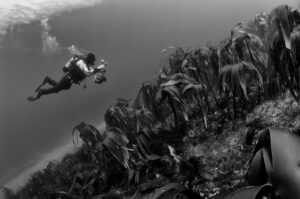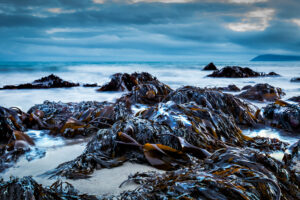Marine Biodiversity
Habitat: Open Marine Water
Species: Forest Kelp (Tangle/Cuvie)
Scientific name: Laminaria hyperborea
Size: Up to 2 m in length
Colour: Dark brown
Distribution: Widespread along Ireland’s coast
You will often see this seaweed washed up on the shore, sometimes still attached to a stone by its holdfast. It is dark brown in colour with a long stem or ‘stipe’, often over 1m long, which holds the plant upright towards sunlight filtering down through the water. The stipe is thicker close to the holdfast and gets thinner towards the other end where it divides into multiple flat, smooth fronds.
This is the dominant type of kelp found in Irish waters and it is found all around the island’s coastline. It is found from the extreme low water mark extending out into the depths of about 30 meters, as long as the water is clear enough for the kelp to photosynthesise. Forest kelp typically attaches itself to bedrock on the seafloor or other stable stones or material. It can grow in dense forests or ‘beds’ under suitable conditions, hence the name, with plants living up to 20 years.
These kelp forests are valuable habitats for marine creatures, often providing shelter from waves or currents. In fact, there are many types of organisms and algae that only live on either the holdfast, stipe or fronds of this kelp. In late winter and spring, the kelp sheds its frond, together with all the attached creatures, and grows a new one. To avoid being discarded, the blue-rayed limpets that graze on the frond climb down the stipe and into the holdfast before the old frond is shed.
Washed–up kelp has long been collected as an agricultural fertiliser and soil conditioner. More recently kelps have been harvested for the alginate industry which produces valuable emulsifiers and gelling agents for cosmetic, pharmaceutical and food industry.

Image by Damien McGuirk

Images by Stephen Paterson
